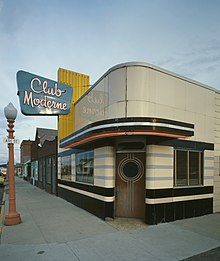Moderne architecture, also sometimes referred to as Style Moderne or simply Moderne, Jazz Age, Moderne,[1] Jazz Modern or Jazz style, describes certain styles of architecture popular from 1925 through the 1940s. It is closely related to Art Deco.[2] Both belong to the architectural Modern Movement, which broke with tradition on purpose to create a fresh look that was uninfluenced by earlier forms and styles.[3]


Originating in the International Exhibition of Modern Decorative and Industrial Arts held in Paris in 1925, the style has expression in styles traditionally classified as Art Deco, Streamline Moderne, Late Moderne, and, in the U.S., PWA/WPA Moderne. Architectural historian Richard Guy Wilson characterized the style by the eclectic co-existence of "traditionalism and modernism".[4]
The Bauhaus movement
editThe Bauhaus movement, along with architects like Walter Gropius and Mies Van Der Rohe, Kickstarted Modernist architecture in Germany during the 1920s. After the Nazis shut down the Bauhaus in 1933, these architects brought their innovative style to the United States, where it became hugely popular and influential.
Art Deco and Moderne architecture
editEven though they have different aesthetics, the Art Deco and Moderne styles are both occasionally referred to as "Modernistic". A new, more streamlined, less decorated architectural style,[5] the Moderne style of the 1930s was inspired by the Art Deco style, which had smoothly finished wall surfaces and characteristic ornamentation of chevrons, zigzags, and other geometrical motifs.
Characteristics of Moderne Architecture
editThe Moderne style included rounded corners, curved glass, and smooth walls with minimal surface decoration.[6] Moderne architecture features bands of windows with a horizontal emphasis and flat roofs.[7] Certain structures in this style feature curving canopies, glass block window panels, straightforward pipe balustrades, and stainless steel or aluminum details.
Canada
editThe architectural firm of Kaplan & Sprachman introduced the Moderne style of architecture to Canada, designing many movie theatres in that style. The Eglinton Theatre in Toronto and the Vogue Theatre in Vancouver, both designed by Kaplan & Sprachman, as well as the Odeon Theatre in Victoria, designed by Henry Simmonds are still standing and have been designated historical landmarks.[8][9][10][11][12]
United States
editThe Moderne style of architecture appears as a descriptor in documentation of many buildings listed by the United States of America's National Register of Historic Places.[13] In general, there are not many examples of the Moderne style in the United States. It was popular for a comparatively short time until the International style for major commercial buildings swiftly took its place.
Streamline Moderne
editSome Moderne architecture may be classified as Streamline Moderne, an evolution of Art Deco architecture which peaked in popularity c. 1937. This can refer to land-based architecture, such as the Normandie Hotel in San Juan, Puerto Rico, which show curved, shiplike forms and styling. This follows the water-based adaptation of Art Deco decorative style and architecture to passenger ships, such as the SS Normandie. Other Streamline Moderne architecture does not reflect any maritime-oriented themes.[citation needed]
References
edit- ^ Sharp, Dennis (2002). Twentieth Century Architecture: A Visual History. Images Publishing. ISBN 978-1-86470-085-5.
- ^ "Art Deco", Wikipedia, 26 March 2024, retrieved 29 March 2024
- ^ "Art Moderne Moulding & Trim Architecture". Mouldings One. Retrieved 29 March 2024.
- ^ Wilson, Richard Guy (2002). Buildings of Virginia: Tidewater and Piedmont. Oxford University Press. p. 519. Oxford University Press. p. 519.
- ^ Bohan, Peter (September 1991). "Cowtown Moderne: Art Deco Architecture of Fort Worth, Texas Judith Singer Cohen". Journal of the Society of Architectural Historians. 50 (3): 332–333. doi:10.2307/990627. JSTOR 990627.
- ^ "Moderne Style 1930 - 1950 | PHMC > Pennsylvania Architectural Field Guide". www.phmc.state.pa.us. Retrieved 29 March 2024.
- ^ "Moderne Style 1930 - 1950 | PHMC > Pennsylvania Architectural Field Guide". www.phmc.state.pa.us. Retrieved 28 March 2024.
- ^ "Parks Canada - Kaplan & Sprachman, Architects". 15 November 2016. Retrieved 17 October 2024.
- ^ Moore, Shannon (24 November 2016). "Eglinton Theatre and Kaplan & Sprachman Architects recognized for National Historic Significance in Canada". Canadian Architect. Retrieved 17 October 2024.
- ^ "Canada's Historic Places - Eglinton Theatre". www.historicplaces.ca. Retrieved 17 October 2024.
- ^ "Canada's Historic Places - Vogue Theatre". www.historicplaces.ca. Retrieved 17 October 2024.
- ^ "Canada's Historic Places - Odeon Theatre". www.historicplaces.ca. Retrieved 17 October 2024.
- ^ "National Register Information System". National Register of Historic Places. National Park Service. 13 March 2009.